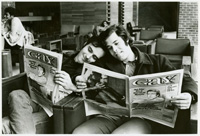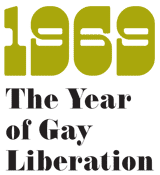Gay News
 |
Reading All About It
Two New York Gay Activists Alliance members reading the
latest issue of Gay at the Rutgers University
Gay Liberation Conference, April 30–May 2, 1971. Photograph
by Kay Tobin Lahusen.
NYPL, Manuscripts and Archives Division, Barbara Gittings
and Kay Tobin Lahusen Gay History Papers and Photographs.
Copyright Kay Tobin Lahusen.
Digital ID: 1606088 |
A small gay political press with national reach —
Mattachine
Review,
One,
The
Ladder,
and
Drum — had existed since
the 1950s to connect communities of gays and lesbians across
the country.
These journals were usually monthly or quarterly, and provided
channels for news and forums for political discussion. But
a newly assertive gay and lesbian voice found its way into
print beginning
in the fall of 1969.
Jack Nichols and his lover, Lige Clarke, had been key figures
in the Washington, D.C., Mattachine Society. After moving to New
York, they were approached by Al Goldstein in 1968 to write a
column, "The Homosexual Citizen," for Goldstein's
Screw magazine.
Through this new mouthpiece, Nichols and Clarke reached ten times
the audience that had been reached by
One,
Mattachine
Review, and
The Ladder. After the
Stonewall Riots, Goldstein backed Nichols and Clarke to create
GAY,
a newspaper covering politics and culture from a gay perspective.
Stories ranged from a review of the off-Broadway play
The
Boys in the Band to coverage of Gay Activists Alliance
zaps to meditations on Mick Jagger's sex appeal to manifestos
on gay witchcraft.
GAY also featured extensive
advertising from businesses seeking gay consumers. Initially published
biweekly, it quickly became the first gay weekly, and the most
profitable gay newspaper in the country.
GAY had been anticipated by a few months by the
appearance of Gay Power, the first gay biweekly
newspaper, edited by John Heys.
Gay Power covered
the culture and politics of the New York gay scene through a very
personal vision. Each issue featured psychedelic covers, fantastic
centerfolds, regular columns by Warhol superstars, astrological
advice, and firsthand accounts from the front lines of gay activism.
Heys went on to become an important star on the downtown scene
as a drag queen, performance artist, and visual artist.

